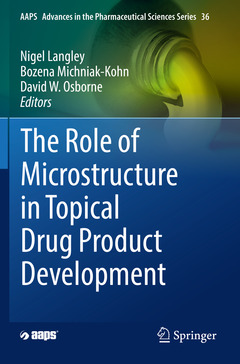The Role of Microstructure in Topical Drug Product Development, 1st ed. 2019 AAPS Advances in the Pharmaceutical Sciences Series, Vol. 36
Coordonnateurs : Langley Nigel, Michniak-Kohn Bozena, Osborne David W.

Part I - Critical Quality Attributes: 1. Rheological Characterization in the Development of Topical Drug Products.- 2. In Vitro Release & Permeation Tests as Critical Quality Attributes in Topical Product Development.- 3. Determination of Particle Size and Microstructure in Topical Pharmaceuticals.- Part II - Role of API and Excipients: 4. Quality Assessment of API in Semisolid Topical Drug Products.- 5. The Role of Excipients in the Microstructure of Topical Semi-solid Drug Products.
Nigel Langley, Director Technical Service and Scientific Affairs – BASF Pharma Solutions, provides technical support to the pharmaceutical industry and helps solve drug development challenges with BASF's platform solutions. Prior to joining BASF, Dr. Langley worked for Croda Inc. as Technical Director Health Care, responsible for product and application development for both dietary supplements and Pharmaceutical excipients. He has also worked in Japan and England with Croda. He gained his Chemistry (Hons) degree and PhD (Liquid Crystals) from the University of Hull, (UK) and an MBA from Leeds University (UK). Nigel has been a member of the Executive Committee at IPEC Americas since 2010 and is currently VC membership. He is also helping to lead the Novel excipient initiative in collaboration with the IQ Pharma Consortium. Nigel has 30 years’ experience within the Pharmaceutical excipient industry.
Dr. Bozena B. Michniak-Kohn is a tenured Professor of Pharmaceutics at the Ernest Mario School of Pharmacy, and Founder /Director of the Center for Dermal Research CDR at Rutgers, The State University of New Jersey. Her main focus is topical, transdermal and buccal drug delivery. Dr. Michniak-Kohn has nearly 40 years’ experience in design & optimization of topically applied formulations and transdermal patches. Dr. Michniak-Kohn received her B. Sc. (Honors) in Pharmacy and Ph.D. in Pharmacology from the U.K. Dr. Michniak-Kohn has directed over 50 Ph.D. and Masters students and the work resulted in over 135 peer-reviewed manuscripts, over 425 abstracts, 2 books, and 35 book chapters. She is a member of 10 journal editorial boards, several scientific advisory boards, member of Board of Trustees at TRI, Princeton and is a reviewer for about 44 pharmaceutical and drug delivery journals. For this work, she was awarded Fellow status of the American Association of Pharmaceutical Scientists (AAPS) in 2008.
<Date de parution : 08-2020
Ouvrage de 199 p.
15.5x23.5 cm
Date de parution : 08-2019
Ouvrage de 199 p.
15.5x23.5 cm



